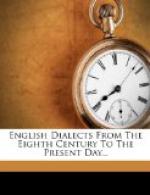But before this can be appreciated, it is necessary to draw attention to the fact that the literature of the fifteenth century, in nearly all the text-books that treat of the subject, has been most unjustly underrated. The critics, nearly all with one accord, repeat the remark that it is a “barren” period, with nothing admirable about it, at any rate in England; that it shows us the works of Hoccleve and Lydgate near the beginning, The Flower and the Leaf near the middle (about 1460), and the ballad of The Nut-brown Maid at the end of it, and nothing else that is remarkable. In other words, they neglect its most important characteristic, that it was the chief period of the lengthy popular romances and of the popular plays out of which the great dramas of the succeeding century took their rise. To which it deserves to be added that it contains many short poems of a fugitive character, whilst a vast number of very popular ballads were in constant vogue, sometimes handed down without much change by a faithful tradition, but more frequently varied by the fancy of the more competent among the numerous wandering minstrels. To omit from the fifteenth century nearly all account of its romances and plays and ballads is like omitting the part of Hamlet the Dane from Shakespeare’s greatest tragedy.
The passion for long romances or romantic poems had already arisen in the fourteenth century, and, to some extent, in the thirteenth. Even just before 1300, we meet with the lays of Havelok and Horn. In the fourteenth century, it is sufficient to mention the romances of Sir Guy of Warwick (the earlier version), Sir Bevis of Hamtoun, and Libeaus Desconus, all mentioned by Chaucer; Sir Launfal, The Seven Sages (earlier version, as edited by Weber); Lai le Freine, Richard Coer de Lion, Amis and Amiloun, The King of Tars, William of Palerne, Joseph of Arimathea (a fragment), Sir Gawain and the Grene Knight, Alisaunder of Macedoine and Alexander and Dindimus (two fragments of one very long poem), Sir Ferumbras, and Sir Isumbras. The spirited romance generally known as the alliterative Morte Arthure must also belong here, though the MS. itself is of later date.




